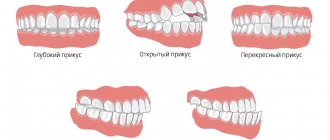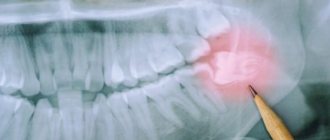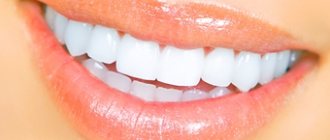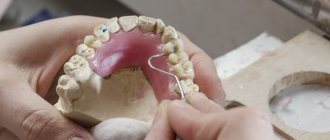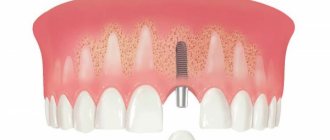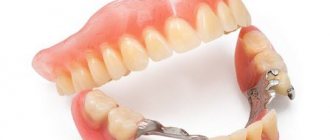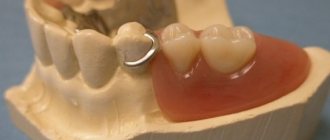Edentia (complete or partial absence of milk or permanent teeth) is the absence of some teeth or all at once. Occurs, as a rule, as a result of an anomaly in the formation of tooth germs during the embryonic period. At first glance (judging by the name), the disease is quite rare, but in fact, complete or partial absence of teeth is quite common in people both in early and adulthood.
Partial and complete edentia (illustration)
Diagnosis: complete absence of teeth
Partial edentia means that the patient is missing several teeth. Multiple edentia is a condition in which more than 10 teeth are missing. If the patient has lost the entire dentition - on one or both jaws, then the doctor diagnoses “complete edentia”. As a rule, people in adulthood face this problem, but in exceptional cases, this diagnosis can occur in young people and even children.
There are two types of edentia.
- With primary adentia,
a person is born with dead/undeveloped tooth rudiments. Even partial primary adentia occurs in only 1% of cases of all dental anomalies, and complete primary adentia is an extremely rare diagnosis. The congenital absence of tooth buds is caused by various hereditary factors or diseases that provoke disturbances in the development of the dental plate. Thus, the cause of congenital adentia can be ichthyosis, hypothyroidism, pituitary dwarfism, and infectious diseases. - Secondary complete adentia
is most common in adulthood, affecting about 20% of people over 65 years of age. This form is considered acquired; it is provoked by:
- metabolic disorders;
- age-related changes;
- injuries to teeth and jaw;
- gum disease;
- caries and its complications.
Periodontitis, periodontal disease, periostitis, pulpitis, periodontitis without high-quality and timely treatment can lead to complete or partial adentia even at a young age.
Demmy Moor
“All diseases come from nerves,” stars without teeth can say. Demi Moore has had dental problems since childhood. Genetics failed: the teeth crumbled and suffered from caries. Dentists created a Hollywood smile in the celebrity's mouth.
Despite the dentists' efforts, Demi admitted that her teeth still hurt. And recently, fans saw a photo where the actress does not have an incisor. It turned out that two front teeth fell out at once due to nervousness. Dentists installed implants for the performer, and now she again shines with a snow-white smile.
It's only June, but we're guessing all Demi Moore wants for Christmas is her two front teeth: https://t.co/r0oa43AzNz pic.twitter.com/FbQdubn9kS
- E! News (@enews) June 14, 2022
Orthopedic treatment of complete edentia
In case of complete edentia, the doctor can offer two main correction options: implantation followed by prosthetics or wearing a complete removable denture.
Removable dentures were very popular before the advent of implant prosthetics, accessible to a wide range of people. Now removable dentures are used, but are not considered the optimal solution to the problem. In modern dentistry, several types of removable dentures are used:
✔
acrylic;
✔
nylon.
Acrylic removable dentures consist of a solid base and attached artificial teeth. The lack of flexibility gives these prostheses several special qualities, which are both the main advantage and the main disadvantage. On the one hand, a solid base contributes to an even, healthy load on the entire jaw when chewing food. However, this same property makes the prosthesis more fragile and less comfortable to wear compared to more elastic structures. Acrylic dentures have a porous structure on which bacteria and plaque accumulate; the monomer in their composition can cause an allergic reaction. When choosing this design, we recommend paying attention to Acry Free prostheses, made from the latest type of plastic without toxic substances. They are more modern, durable and flexible, but their cost is higher than other acrylic prostheses.
Nylon prostheses are more flexible and aesthetic. They are made from hypoallergenic materials. However, they have insufficient rigidity, which affects the quality of chewing food and contributes to rapid atrophy of bone tissue. Because of this, nylon dentures made of polyurethane and other materials are not recommended for use in completely toothless jaws.
Shura
Alexander Medvedev, known as Shura, lost his teeth during a fight with his younger brother, but made the gaps part of his stage image. The flamboyant singer complemented the audience's impression with ridiculous outfits and smiled broadly at the camera.
Over time, the “zest” stopped bothering fans and the performer got implants. However, the procedure was not easy. The emptiness caused the destruction of bone tissue. Therefore, it was necessary to build up the bone at the root. And only then restore the teeth.
View this post on Instagram
A post shared by Shura Medvedev (@shuramedvedev) on Nov 27, 2019 at 1:45am PST
Completely edentulous upper jaw
In case of partial absence of teeth, the prosthesis rests on the remaining units. If it is full, there is no such possibility of fastening, which may cause difficulties with the installation of the prosthesis. Therefore, dentures for the upper and lower jaws have significant design differences. Dentures for the upper jaw include a volumetric base that imitates the anatomy of the palate, which ensures a tight fit. To improve fixation, special gels are used. Dentures for the lower jaw do not require additional fastening elements, since they repeat its alveolar part.
Taisiya Povaliy
Ideal oral health is a necessity for a vocalist. Singer Taisiya Povaliy did not hide the fact that her beauty is the result of the work of dentists. First, her nerves were removed and crowns and bridges were installed. But outdated technologies contributed to further tooth decay, and the moment came when the star installed implants.
View this post on Instagram
A post shared by Taisiya Povaliy (@tpovaliyofficial) on Dec 17, 2019 at 8:11am PST
Taisiya Povaliy with implants
Which prosthetics are better for complete edentia?
Classic removable dentures are affordable, but they are not able to provide everything necessary for a high quality of life:
- functionality;
- comfort to wear;
- quality of chewing food;
- healthy load on the jaw;
- restoration of the natural shape of the face.
This is a half-measure that does not allow us to fully restore a decent quality of life. This is why dental implantation is the best solution for complete edentia. Computer modeling methods allow you to understand what your smile and overall face will look like even before implants and prostheses are installed. At the same time, computer programs help to accurately determine the location of future implants to restore the natural shape of the face, eliminate deep wrinkles, hollow lips and cheeks caused by missing teeth.
In case of complete absence of teeth, two concepts of implantological treatment are provided: classical and mini-implantation.
With mini-implantation, which is considered a temporary solution, the prosthesis is installed immediately after implantation. With mini-implantation, only removable prosthetics are available, and the design is inferior to classical prosthetics in terms of reliability and durability.
In the classic version, the patient undergoes the procedure of engrafting several implants - artificial roots made of titanium, which will serve as support for the future prosthesis. To securely attach the prosthesis, a minimum of 4 implants are required in the upper jaw and 3 in the lower jaw. But in a number of clinical cases, to achieve better stability, it is recommended to use a larger number of implants. After 6 months, when the implants have finally taken root, a permanent prosthesis is installed on them.
Nicolas Cage
Hollywood handsome Nicolas Cage delights viewers with a snow-white smile with 32 teeth. And back in 1984, the actor agreed to voluntarily part with two teeth right in the frame of the film “Bird”. “What can’t you do for the sake of art,” the actor’s fans concluded, and they were wrong.
It turned out that the pragmatic performer had long dreamed of correcting problems in the oral cavity. And for this it was necessary to remove a couple of teeth. This is what Cage did right on camera and without anesthesia. And then he placed implants and ceramic veneers.
Nicolas Cage, still from the movie "Bird"
Features of treatment
Complete dentures on implants can be removable or conditionally removable. Removable ones are used for mini-implantation. Conditionally removable dentures are removed only in the dentist's office.
In classical prosthetics on implants, different fastening methods are used.
- Push-button fixation
is carried out using abutments - equatorial or spherical. When the prosthesis is fixed, the lock is activated. With some force, the prosthesis can be removed for inspection and hygiene procedures. - Another method is beam fixation.
First, a beam is made to connect the already installed implants. The prosthesis itself is attached to it. Prosthetics using this method are more reliable, but more expensive. From a technical point of view, it is more difficult to carry out.
Tom Cruise
It turns out that healthy teeth turned out to be a mission impossible in the life of actor Tom Cruise, but in the spirit of the franchise, he corrected the situation. At the beginning of his cinematic career, Cruise had little chance of breaking into the stars of the first echelon: his front tooth was knocked out by a washer, and the rest were uneven and located at different distances.
The young man's diligence in the dentist's chair paid off. The bite was corrected, the teeth were whitened, porcelain crowns were installed, as well as implants and veneers. As a result, Tom Cruise pleases with a smile that makes girls simply melt.
View this post on Instagram
A post shared by Bubago (@bubagobubago) on Jul 4, 2022 at 8:15am PDT
Bite with complete absence of teeth
With complete edentia, the jaw looks unaesthetic, and the shape of the patient’s face changes significantly. In this situation, specialists need to recreate the correct bite so that the prosthesis does not protrude or sink.
In order for the prosthesis to fit correctly, correcting aesthetic and functional problems caused by edentia, it is necessary:
- calculate the occlusal height of the upper jaw;
- form a prosthetic plane;
- determine the height of the lower facial region;
- determine the central relationship of the jaws and fix it with notches.
To determine central occlusion, the doctor holds the corners of the patient's mouth. After the patient swallows saliva, the jaws close correctly.
Effects on soft tissue
As the bone loses width, then height, width, and height again, the attached gum gradually decreases. When there is severe atrophy of the lower jaw, it is usually covered by a thin layer of attached tissue or is completely absent. The gums are prone to sedimentation, which is caused by the overlying prosthesis.
Conditions such as hypertension, diabetes, anemia, and eating disorders have a devastating effect on the blood supply and quality of nutrition of the soft tissues under the removable denture. As a result, the thickness of the surface tissues gradually decreases. All this leads to the formation of bedsores and discomfort from wearing removable dentures.
A patient's tongue with edentulous ridges often enlarges, filling the space previously occupied by teeth. At the same time, the tongue is used to limit the movement of the removable denture and takes a more active role in chewing.
What types of dental prosthetics exist if only one tooth is missing?
If the destruction is so great that there is nothing left to save, you will still have to resort to removal. So, one tooth had to be removed, and now there is an unsightly empty space in its place. You should not wait for the “neighbors” in the dentition to move into the vacant space, disrupting the bite and interfering with normal chewing of food. It is better to immediately contact an orthopedic dentist, who will select the appropriate way to return the “prodigal” tooth to its place. There are several different ways to do this:
- Implantation.
A method that today is unrivaled in terms of reliability, durability and scope of function restoration. In modern dentistry it is considered simply ideal. If it is possible to carry out implantation, it is better to opt for this method of prosthetics. A titanium “artificial root” is screwed into the jawbone, onto which a crown made of metal-free ceramics or metal-ceramics is then installed. A very reliable and durable method that not only returns aesthetics to the dentition, but also almost completely restores its functions. - Bridge prosthesis.
A dental “bridge” is made of three interconnected crowns: one replaces a missing tooth, and the remaining two are attached to the supporting teeth and play the role of “bearing beams” of the bridge. The advantages of this method are affordable price and reliability, the disadvantages are the need to grind the supporting teeth, as well as the need to remove the entire prosthesis if it breaks. - Adhesive prosthetics .
The method is similar to installing a conventional bridge with support on the teeth adjacent to the defect. But at the same time, turning these “supports” is not required: the doctor will simply make micro-incisions on the tooth enamel, into which he will place a strong fiberglass thread and secure it with the help of composites. A more gentle and faster method of prosthetics than installing a “classical” bridge, but not as durable and reliable (recommended only for front teeth that do not bear the same load as chewing teeth). - CBW prosthetic system with micro-locks
. Here, too, neighboring teeth are used as a support for the prosthetic crown, but they do not have to be ground down. It will be enough to make small holes to fix the micro-locks that will hold the crown. A fairly reliable and quick way to restore a defect, however, dentists consider it not very durable and often recommend using it as a temporary option. - Immediate prosthesis, or “butterfly”.
What could be easier than installing a neat, removable structure with nylon or metal wire fastenings? Such a prosthesis does not scratch the enamel, is quickly installed and removed just as quickly, and does not require grinding of dental tissues. It would seem like a patient’s dream. But in fact, an immediate denture is quite uncomfortable when worn constantly, it is short-lived and is not intended to permanently replace a lost tooth. This is a temporary structure, which is usually installed for the period while a permanent prosthesis is being made.
Comparing prices: which method is more affordable?
The cheapest option is an immediate prosthesis, its cost will be about 2000-5000 rubles. But, as already mentioned, this is a temporary solution: you can wear it for no more than 2-3 months, and then you will need to change it to a permanent structure. An adhesive prosthesis will cost about 6,000-10,000 rubles, which is a very reasonable price for good aesthetics and reliable fixation. However, in terms of durability, adhesive structures are inferior to the same bridges (their price is the sum of the cost of individual crowns; if one crown costs 20-40 thousand rubles, then for a bridge this amount should be multiplied by three). Implantation will cost 20-70 thousand rubles, depending on the type of implant chosen. That is, implantation costs about the same as a good bridge structure, but at the same time it is much more reliable, more durable and does not require grinding of supporting dental units.
Expert opinion
Roman Borisovich Alekperov
orthopedic dentist
Experience: 24 years
The removal of a tooth is a reason to immediately think about its restoration. Ideally, you should think about this even on the eve of removal. So, for example, in some cases, the doctor can offer you the safest, painless and bloodless implantation - when an artificial root is implanted into a fresh socket of a just extracted tooth. Next, a crown is placed on it, and you get a full-fledged new tooth instead of the extracted one.
Psychological aspects of tooth loss
Psychological effects range from minimal to neurotic. It gets to the point that people are not able to wear dentures at all, and thinking that they will have to communicate with someone, they do not leave the house at all.
- Fear of an awkward situation if the prosthesis accidentally detaches.
- Losing teeth affects relationships with the opposite sex
- The occlusal (chewing) load is reduced, and the patient cannot afford to eat all the food he would like.
- Inability to eat in public.
- Speech problems. Diction problems in patients can be very serious.
Online consultation with a doctor
If you are missing a tooth or are undergoing a procedure to remove it. If you are interested in questions about dental restoration, it would be best to undergo an examination and get advice from a dentist. The specialist will assess the condition of the teeth, listen to complaints, interpret the images and give professional recommendations. The doctor will advise you on what treatment options you should pay attention to in your case and answer all your questions. In the absence of even one tooth, changes occur not only of an aesthetic nature, but also of a functional nature, in organs far from the jaw. Treatment will be more expensive and, in some cases, longer.
At the consultation, the vector of your next actions will be set and doubts will be dispelled.
The most important teeth in the mouth
Are you familiar with this situation: a chewing tooth broke or the doctor removed it. At first, you think about immediately seeing a doctor for restoration, you calculate your options, but gradually your enthusiasm fades away and the tooth remains untouched for many years.
A missing tooth is not visible – why restore it?
There are no unnecessary elements in our body and every tooth plays an important role. For example, all the front teeth are responsible for forming a smile and supporting the position of the lips; we also use them to bite food in order to then chew it with molars. The canines shape the oval of the face, force certain muscles of the temporomandibular joint to work, and support the curve of the jaw. Chewing teeth, in addition to bearing most of the load of chewing food, also support the cheeks and form the oval of the face.
Dental restoration forever!
Installation of a two-stage implant ROOTT (Switzerland) - RUB 32,000. Express implantation ROOTT immediately with a crown - 44,000 rubles.
Chew and smile on day 3!
Missing teeth and aging
The absence of teeth significantly affects our external age: wrinkles appear, lips and cheeks recede. The skin becomes paler, the face becomes haggard. Let's try to understand the reasons - why even the absence of one tooth affects our age so dramatically?
- Immediately after tooth extraction, the jaw becomes deformed . Due to the absence of a tooth root, all metabolic processes in the jaw bone tissue gradually stop, the capillaries contract, and the bone partitions dissolve. A depression is created in the bone and gum - neighboring teeth begin to move towards the resulting space - the bite is bent. In addition, as the teeth change position, some of the muscles are tightened, while others, on the contrary, are weakened. New wrinkles appear, or old ones get stronger, the cheeks begin to fall inward;
- if the front teeth are missing, then the lips begin to fall inward - additional wrinkles appear in the nasolabial area;
- When we are young, our skin is elastic, but with age, its elasticity decreases. The longer teeth are missing, the more the jawbone becomes deformed and shrinks. The gums also sag noticeably, so the shape of the face changes, asymmetry appears, and the corners of the lips gradually sink down.
Let's summarize: even due to the absence of one tooth, the jawbone is deformed over time, the tone of the facial muscles is lost, which leads to the appearance of wrinkles, the cheeks sag and fall inward, the face lengthens... and this is not a complete list of what the absence of teeth affects.
